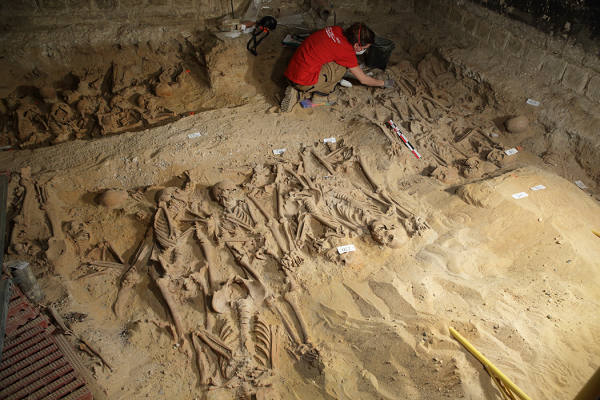Great Plague In London Discovery: Yersinia Pestis DNA, Bacteria Behind Bubonic Plague, Found In Skeletons

Researchers at the Museum of London Archeology recently discovered the strain of bacteria that caused the Great Plague of London in 1665, or bubonic plague, National Geographic reported Thursday.
Last year during construction of the new Crossrail underground rail link beneath London, skeletal remains were found of people who had died from the disease after Liverpool Street excavation cut through the Bedlam Burial ground, which was used to burry infected residents between 1569 and the early 18th century. Scientist retrieved over 3,300 skeletons and confirmed DNA of Yersinia pestis – the bacteria known to be responsible for the bubonic plague in the 14th century – had been found in the remains of five bodies.
The Yersinia pestis DNA was found in the dental remains, which confirms they did die specifically due to the bubonic plague. Researchers say the discovery will shed new light on the Great Plague of 1665 and help solve mysteries regarding how fast and viciously the bacteria spread in the community. The 1665 epidemic was the last bout of bubonic plague outbreaks in Britain and caused the death of over 100,000 Londoners in 18 months. Scholars affiliated with the study believe this new discovery can help answer questions to exactly how that happened.
“It does not behave that way today. It’s much slower and spreads less dramatically. Could it be that there was some form of mutation?” Don Walker, senior osteologies at MOLA, suggested. “Or was it to do with host susceptibility and response? Were humans carrying greater disease loads in those days and had poor nutrition, making them more vulnerable?”
As for the next steps, researchers want to see how – if at all – the Yersinia pestis DNA can be linked to another strain of the bacteria recovered from a 14th century plague pit previously discovered in a different area of London.
“We want to know if there was a local [or] European plague focus – a reservoir of the disease within a rodent population – or were there separate waves of the plague coming from Asia,” Walker said. “Current evidence suggests the former.”
Molecular palaeopathologist Kristen Bos, who drilled out teeth during the study after remains were sent to Germany’s Max Planck Institute for the Science of Human History, told BBC News that the latest discovery of Yersinia pestis will help scientists link the outbreaks in the past up to more modern versions of the plague today.
"We don't know why the Great Plague of London was the last major outbreak of plague in the UK and whether there were genetic differences in the past, those strains that were circulating in Europe to those circulating today,” she said. “These are all things we're trying to address by assembling more genetic information from ancient organisms."
Researchers are also hoping to find out more information on the five victims whose remains were discovered infected with Yersinia pestis.
© Copyright IBTimes 2024. All rights reserved.






















